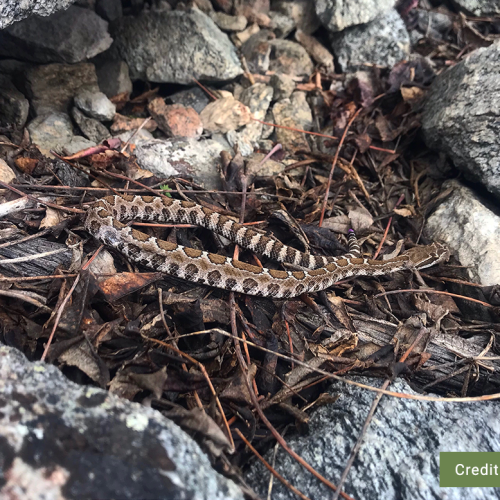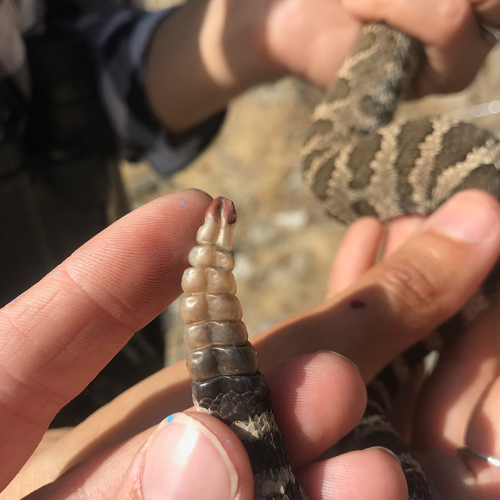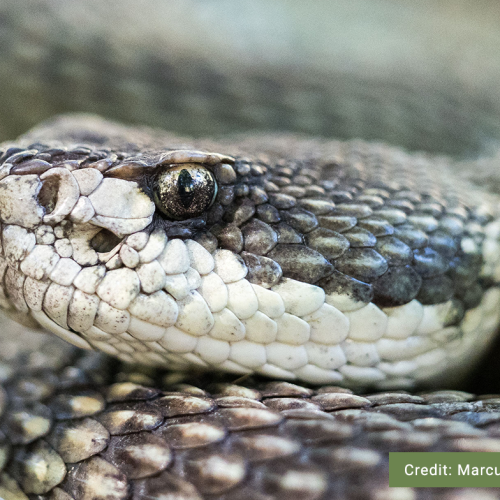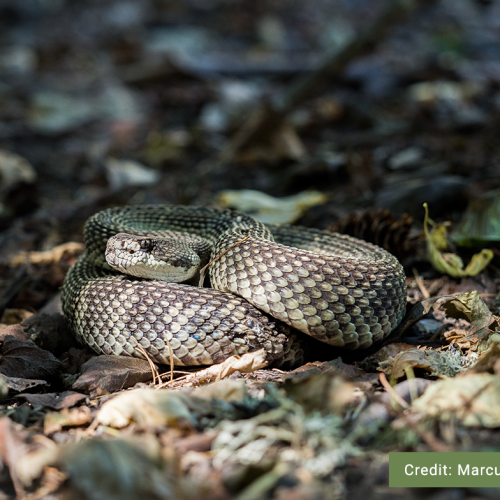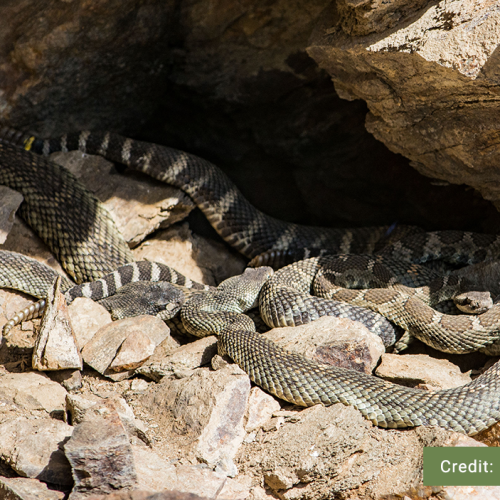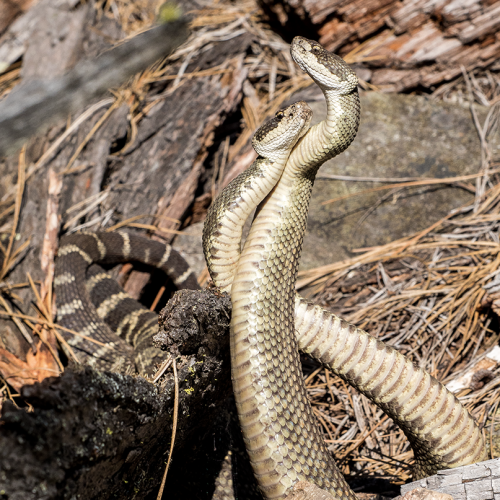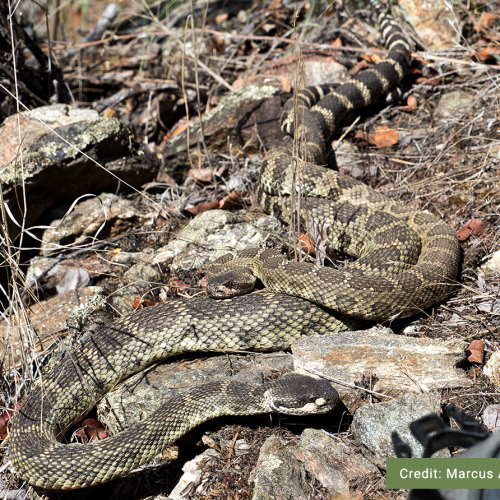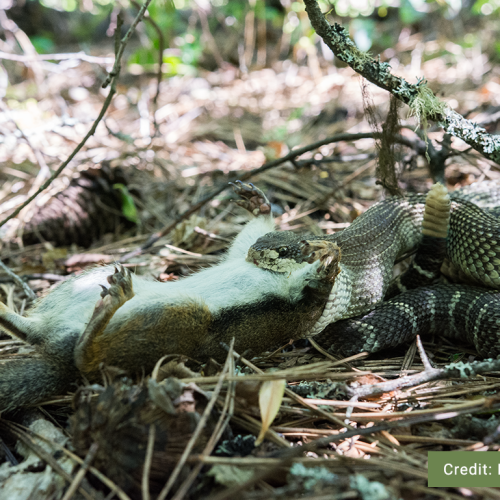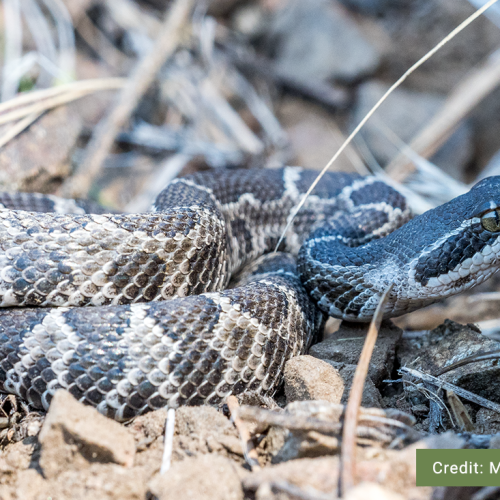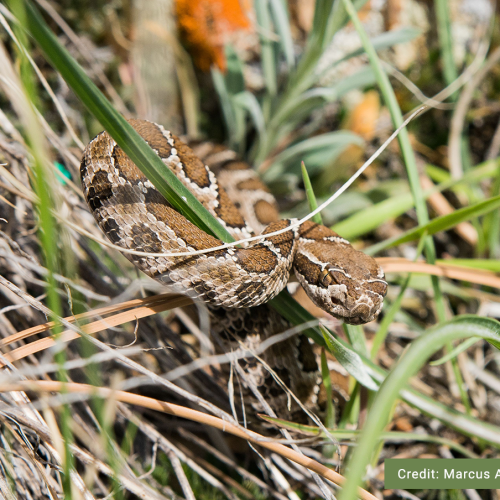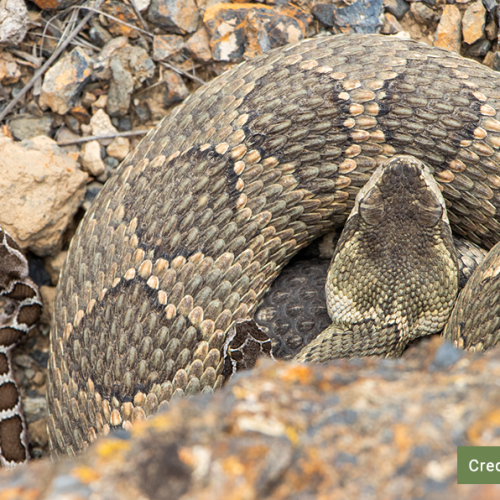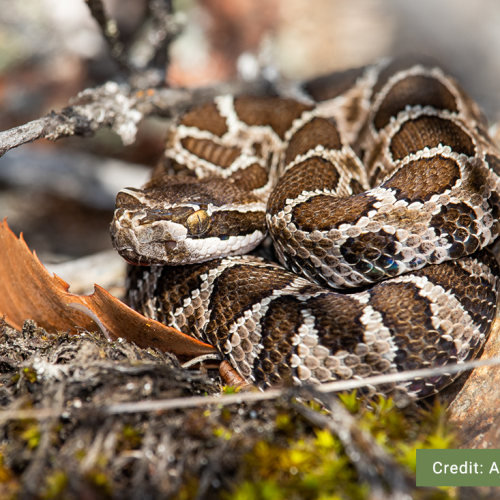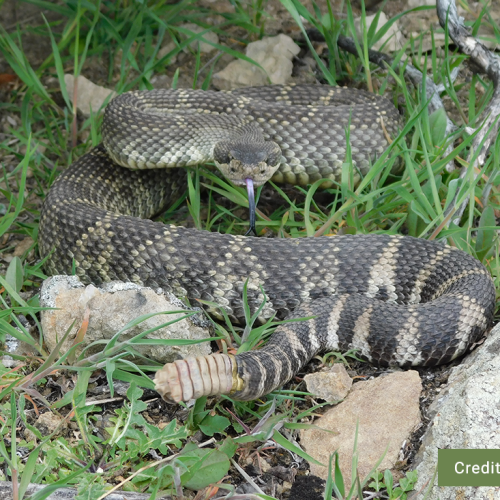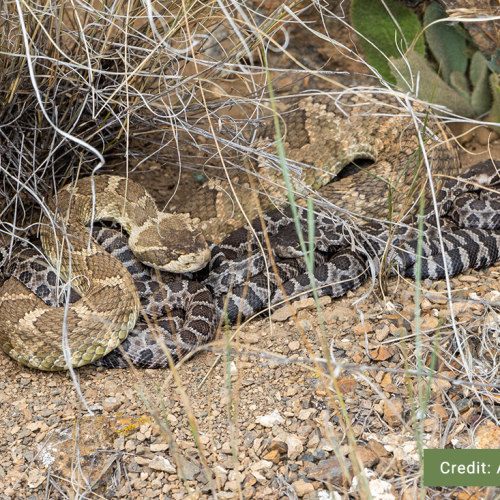Credit: Andrew Nydam
Western Rattlesnake
Crotalus oreganus
Description
Other names: Northern Pacific Rattlesnake; Crotalus oreganus oreganus
Previously referred to as: Crotalus viridis oreganus
Listen to the Indigenous words for “rattlesnake” here!
Click below to hear the sound of a
rattlesnake shaking its rattle!
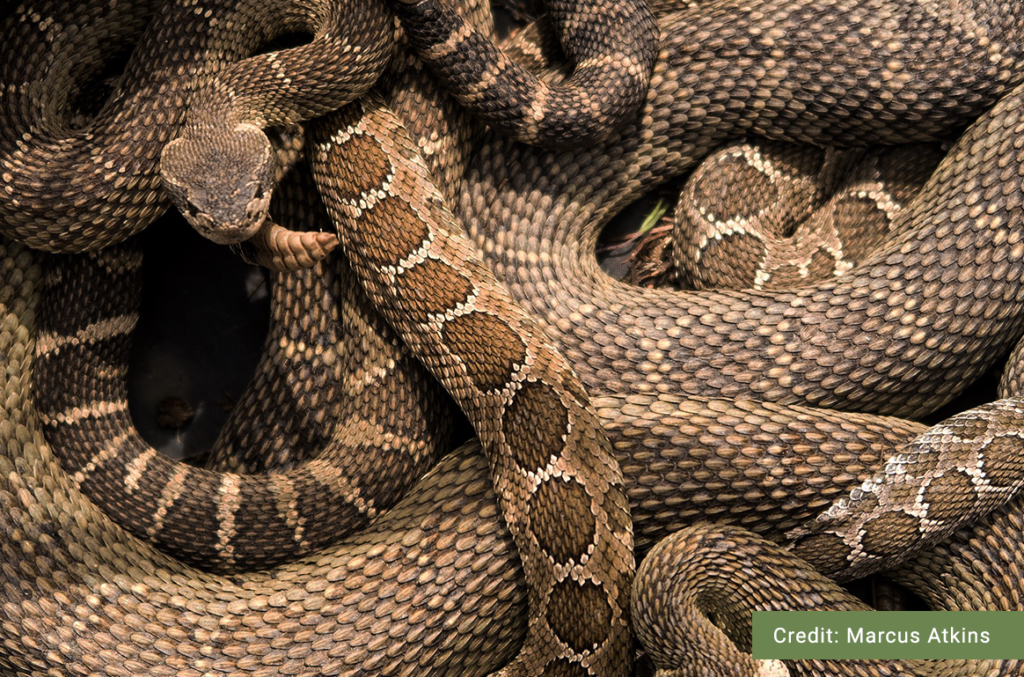
Click below to hear the sound of a
rattlesnake shaking its rattle!
Similar Species
The Western Rattlesnake is the only species of rattlesnake in British Columbia, but there are other blotched species that may resemble them, like the Great Basin Gophersnake or the Desert Nightsnake. Neither of these other species has a rattle, nor are they venomous. The Gophersnake has a much smaller, skinnier head, eyes with round pupils, and a skinny tail that tapers to a fine point. Desert Nightsnakes are very rare in British Columbia and are considerably smaller than Western Rattlesnakes, with a small, skinny head.
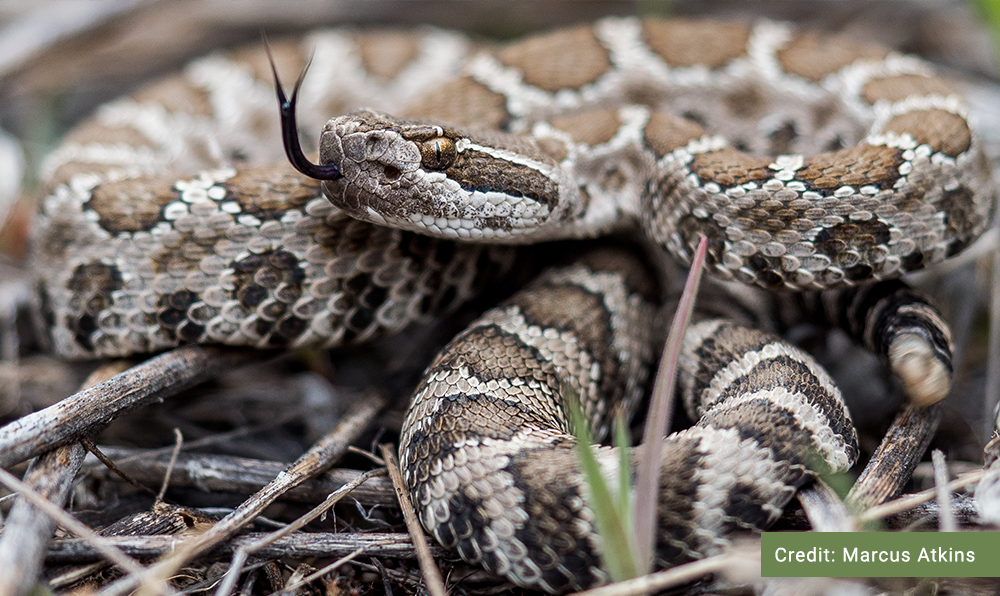
Western Rattlesnake
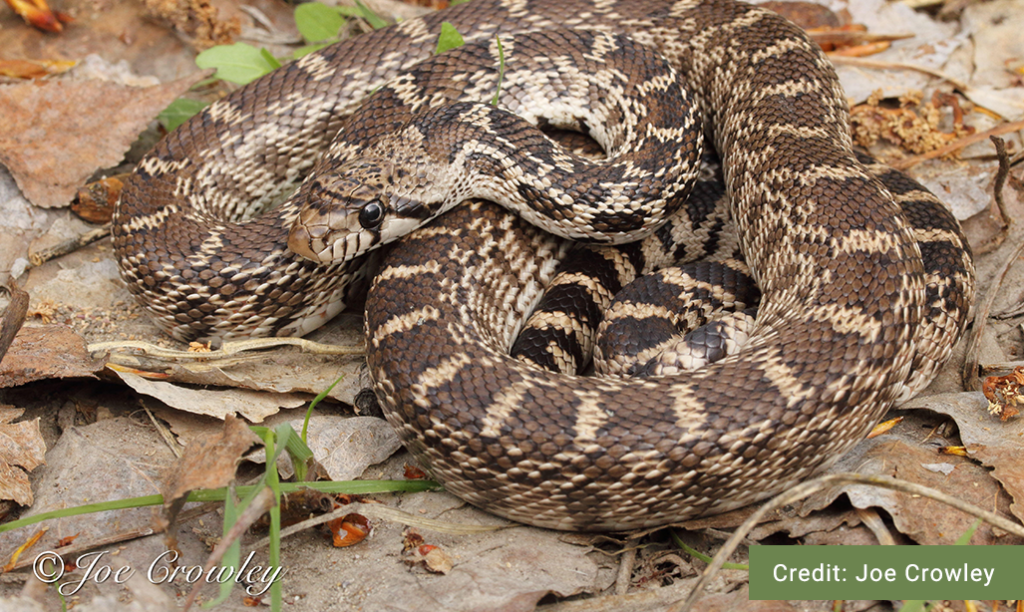
Great Basin Gophersnake
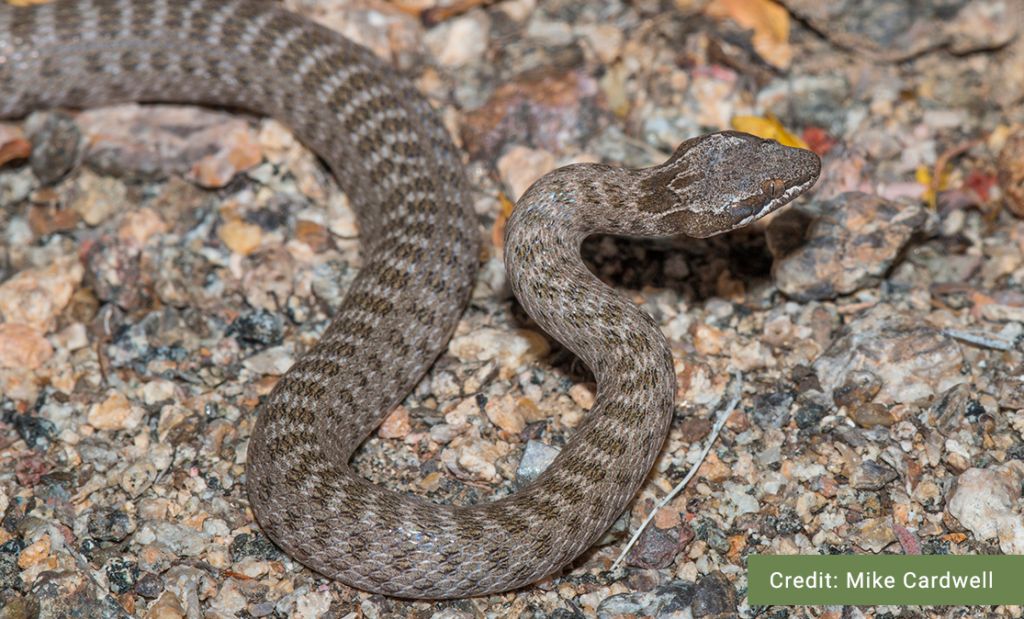
Desert Nightsnake
Habitat
Western Rattlesnakes hibernate throughout the winter in underground hibernaculaDefinition:Winter dwelling of a hibernating animal. that they share with other Western Rattlesnakes, and sometimes other snake species such as Great Basin Gophersnakes, Western Yellow-bellied Racers, and Common and Western Terrestrial Gartersnakes. They have a high fidelity to their hibernacula and return to the same sites every year. When temperatures rise in the spring, they emerge from their dens and make migrations to summer hunting grounds. Pregnant females on the other hand, typically stay very close to the hibernacula, basking on south-facing slopes that provide heat and shelter for the developing embryos they carry. Rattlesnake hibernacula are typically located on south-facing cliffs with rocky outcrops or talus. During the summer, rattlesnakes are generally found in the more productive valley bottoms and adjacent slopes where they hunt. Western Rattlesnakes may migrate several kilometers between their summer foraging grounds and their overwintering dens. In British Columbia, Western Rattlesnakes are associated with arid grasslands and sagebrush shrub-steppe. During the hottest parts of the summer, rattlesnakes are generally nocturnalDefinition:Active during the day. and may even venture into cooler, high-elevation forested habitats.
Reproduction
Western Rattlesnakes, unlike most of the other snakes in British Columbia, do not mate in the spring, but rather in the late summer or early fall. Females that have sufficient fat reserves and are ready to reproduce will leave an ‘odour trail’ as they move about the habitat that males will seek out and follow. After mating, the female will carry the sperm overwinter, not allowing the eggs to be fertilized yet. In the following spring if she has maintained adequate fat reserves to have a successful pregnancy, the eggs will then be fertilized. During the pregnancy females have a very reduced appetite, and provide most of their fat reserves to the developing embryos. Western Rattlesnakes are ovoviviparousDefinition:A reproductive strategy where eggs develop and hatch inside the mother’s body, with the young feeding off the yolk sac until shortly after birth., and when 2-8 live young are born in the autumn, the females haven’t eaten for nearly an entire year and are very skinny. The following summer (or sometimes two summers) are spent feeding and regaining body mass to acquire enough fat reserves to reproduce again. Larger, fatter females will have larger litters than smaller, skinnier individuals. Females don’t reach sexual maturity until 4-7 years of age, depending on their fat reserves, and will reproduce every 1-3 years. Males reach sexual maturity as early as 3 years of age, however, breeding females are limited in any given year and males will aggressively compete for breeding rights, with the largest males usually emerging victorious from such confrontations. Western Rattlesnakes may live up to 30 years.
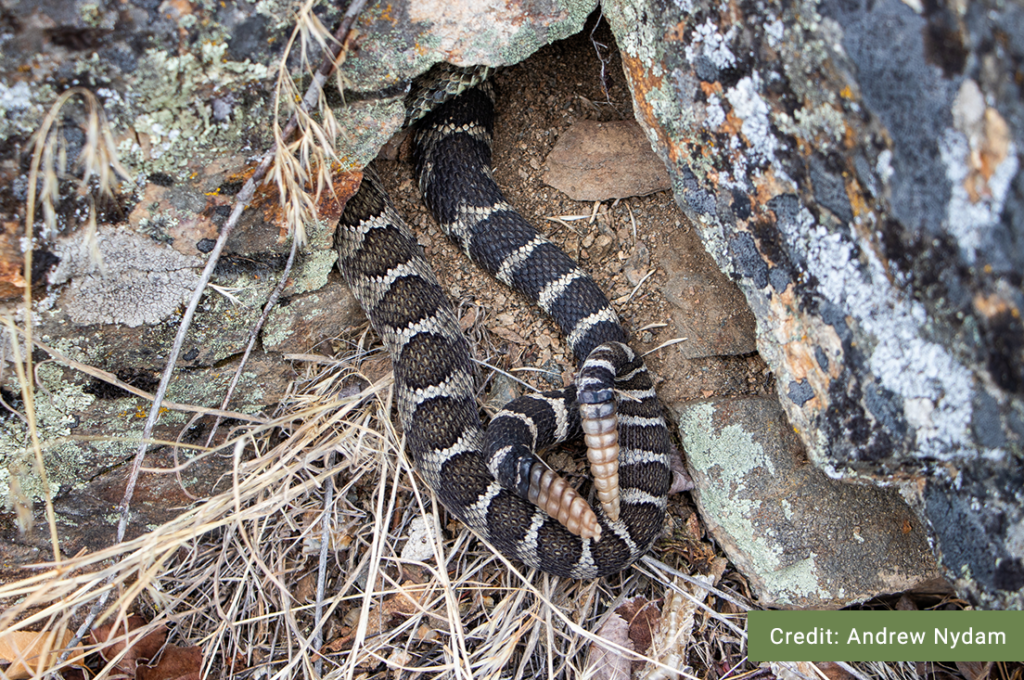
Diet
Western Rattlesnakes mainly eat small mammals like mice, voles, chipmunks, and squirrels. However, larger rattlesnakes may be able to take larger or more complex prey like marmots, rabbits, or birds. Juveniles are limited by their size in what they can eat, and mainly hunt shrews and nestling mice and voles.

Conservation Status
Global: G5 (2016)
COSEWIC: T
SARA:1-T (2005)
Provincial: S2S3 (2018)
BC List: Blue
Learn more about conservation status rankings here
Threats
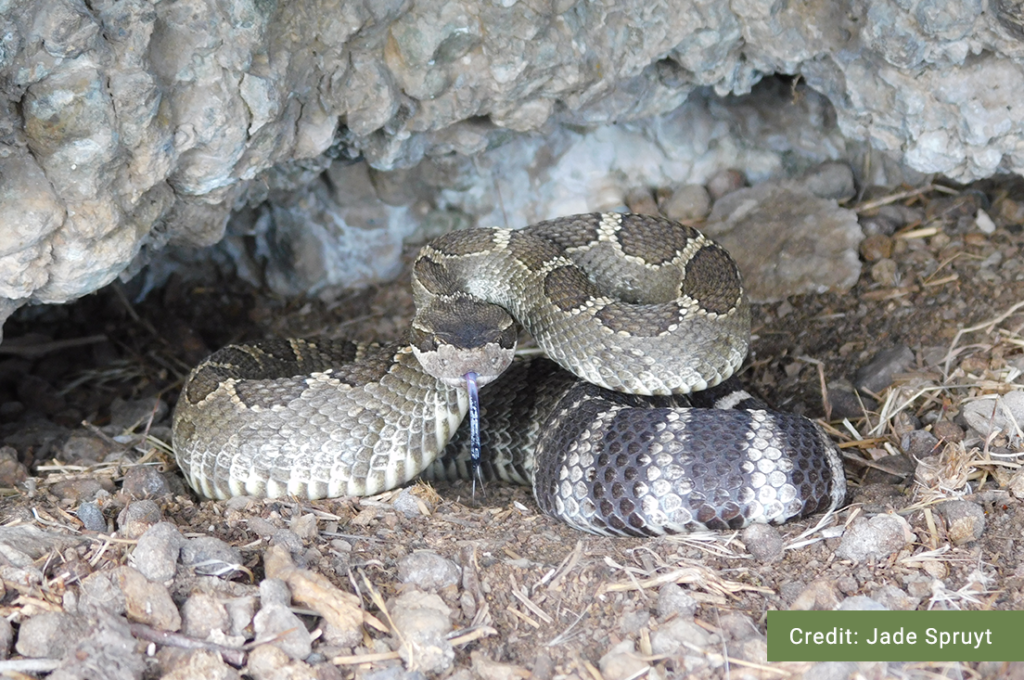
What to do if you encounter a rattlesnake?
The Danger of the Rattlesnake Bite
The best way to prevent a rattlesnake bite is by being prepared and aware of your surroundings. Rattlesnake bites can easily be avoided by staying on trails and being aware of where you place your hands and feet. If you know you are venturing into rattlesnake habitat, make sure to wear closed-toe shoes and long pants; even light pants have been shown to reduce the amount of venom a snake may inject if bitten on the leg. The most important thing to remember is that these are timid animals; with common sense and precaution we can minimize danger to both humans and snakes.
Another common myth is that young rattlesnakes are more dangerous than adults. Young rattlesnakes possess full toxicity venom from birth, but have much less volume than an adult. Although juvenile snakes may inject less venom than larger individuals, anyone bitten by a rattlesnake of any size should seek immediate medical attention.
Did You Know?
Western Rattlesnakes rely heavily on their hollow fangs to inject their prey with venom and get the nourishment they need through the summer. The fangs are folded back in the roof of the mouth when not in use, and flip forward when ready to strike. Because the fangs are so important, they have several replacements at the ready so that if a set breaks, another pair is waiting to take their place.
Species Account Author: Marcus Atkins
B.C. Conservation Data Centre. 2013. Species Summary: Crotalus oreganus. B.C. Minist. of Environment. Available: https://a100.gov.bc.ca/pub/eswp/ (accessed Jun 18, 2021).
B.C. Conservation Data Centre. 2018. Conservation Status Report: Crotalus oreganus. B.C. Minist. of Environment. Available: https://a100.gov.bc.ca/pub/eswp/ (accessed Jun 18, 2021).
B.C. Conservation Data Centre. 2021. BC Species and Ecosystems Explorer. B.C. Minist. of Environ. Victoria, B.C. Available: https://a100.gov.bc.ca/pub/eswp/ (accessed Jun 18, 2021).
COSEWIC. 2015b. COSEWIC assessment and status report on the Western Rattlesnake Crotalus oreganus in Canada. Committee on the Status of Endangered Wildlife in Canada. Ottawa. xi + 44 pp
Environment and Climate Change Canada. 2019e. Recovery Strategy for the Western Rattlesnake (Crotalus oreganus), the Great Basin Gophersnake (Pituophis catenifer deserticola) and the Desert Nightsnake (Hypsiglena chlorophaea) in Canada. Species at Risk Act Recovery Strategy Series. Environment and Climate Change Canada, Ottawa. Part 1, 28 pp., Part 2, A. 37 pp., B. 36 pp., C. 28 pp.
Southern Interior Reptile and Amphibian Working Group. 2016e. Recovery plan for the Western Rattlesnake (Crotalus oreganus) in British Columbia. Prepared for the B.C. Ministry of Environment, Victoria, BC. 37 pp.
http://www.canadianherpetology.ca/species/species_page.html?cname=Western%20Rattlesnake
http://linnet.geog.ubc.ca/efauna/Atlas/Atlas.aspx?sciname=Crotalus%20oreganus
https://www.bcreptiles.ca/snakes/n_pacificrattle.htm 2

